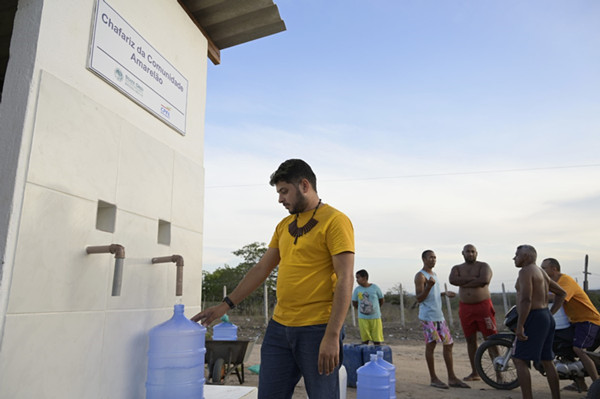China's increased investment eases transition to clean energy in Brazil

A local resident collects water from an outlet at a water desalination project funded by the State Grid Corp of China in the state of Rio Grande do Norte in Brazil. [Photo/Xinhua]
Chinese investment in Brazil has grown significantly in recent years as bilateral relations have deepened.
China's presence is especially felt in Brazil's energy and infrastructure sectors. A recent analysis by Brazilian digital media outlet Poder360 estimated such investment from Chinese enterprises alone has exceeded $51 billion.
Earlier this year, State Grid Corp of China won a 30-year franchise agreement to build a 1,500-kilometer transmission line in northeast Brazil.
"With an investment of 20 billion reais ($3.4 billion), the project will supply 5 million kilowatts of power to regions including the capital Brasilia and is scheduled to be put into operation in 2029," said Wang Xiaogang, chief technical officer at State Grid Brazil Holding.
State Grid entered the Brazilian market in 2010 after the 2008 financial crisis, said Wang. Three Spanish companies in need of capital were trying to get rid of their seven concession power companies in Brazil.
"We took into account that Brazil has a stable political environment, a promising economy, as well as a stable and attractive power transmission regulatory policy with legal protection, and that power transmission is the core business of SGCC and in line with our international development strategy," said Wang.
After due diligence and arduous negotiations, SGCC successfully won the contract for approximately $1 billion for 100 percent of the equity in the seven companies.
"In 2010, State Grid Brazil Holding Company was established, and the acquisition was completed," Wang said. "We took advantage of the opportunity to enter the Brazilian market, laying a solid foundation for our future development here, thus beginning our grand journey in the Brazilian power industry."
Since then, State Grid has won about a dozen power-transmission projects in Brazil. "Among them, the most noteworthy is the Belo Monte project that has been put into operation," said Wang.
The 2,500-km Belo Monte ultrahigh voltage (UHV) transmission project, which started in 2014, was completed in two phases, both ahead of schedule. Chinese President Xi Jinping witnessed the signings of the agreement on three occasions between 2014 and 2019.
State Grid's operations in Brazil are part of its global success.
"We have the world's leading and core technology in UHV transmission and a wide range of construction and operation experience," said Wang. "For more than 20 years, State Grid has maintained the longest safety record of the world's ultra-large power grid and has built 35 UHV transmission projects to form the world's largest power grid with the strongest transmission capacity and the largest scale of new energy grid connection."
The success of the Belo Monte project laid a solid foundation for winning the new Brazil Northeast UHV transmission project, which signifies another leap for clean energy transmission, Wang said.
"The project will integrate and transmit clean energy such as wind power, solar energy and hydropower in northeastern and northern Brazil to central Brazil. It will promote Brazil's clean and low-carbon energy transformation and drive Brazil's economic and social development," he said. "It will also serve as a new breakthrough project in the next golden decade of the Belt and Road Initiative envisioned by President Xi Jinping."
While State Grid is involved in power transmission in Brazil, State Power Investment Corp of China is producing power in the market.
The company arrived in Brazil in 2017 and has since invested 14 billion reais in the country, according to Adriana Waltrick, the CEO of SPIC Brasil. It is a long-term investment company that began its expansion in Brazil in 2017 through the acquisition of Pacific Hydro, she said.
Waltrick said they started with 58 megawatts and today assets total approximately 4 gigawatts. "Currently, we are the sixth-largest private generator in the country, and we aim to be among the top three by 2030," she said.
The first major project was securing the right to operate the Sao Simao Hydroelectric Power Plant for 30 years, she said. It remains the company's largest renewable asset in Brazil to date. Since 2019, more than 1.2 billion reais have been invested over 10 years to modernize the plants, including updating the control system from analog to digital, according to Waltrick.
In 2021, the company started to participate in the natural gas project, Gas Natural Acu, in partnership with Prumo, BP, Siemens and Siemens Energy. That participation aligned with the company's strategy to support Brazil's energy transition with a focus on renewable expansion while ensuring energy security, she said.
In June, the company invested 2.4 billion reais in solar power plants in the northeastern states of Ceara and Piaui, and in November, the company announced a partnership involving the Luiz Gonzaga solar complex with a 400 million reais investment in Pernambuco state.
In partnership with China, the company is also studying the feasibility of producing, storing and transporting green hydrogen from offshore wind sources in ports in Rio de Janeiro and Ceara.
"In summary, we believe in the diversity and complementarity of energy sources," said Waltrick. "Through our partnership with China, we have been exploring new generation possibilities, such as hybridization and integrating batteries into the system, running models and considering pilot projects."
With China expanding investment in energy transition and technology, those projects will contribute to Brazil's new industrialization.
"I am convinced that Brazil can lead the energy transition globally and be at the forefront alongside other major nations such as China," she said.



 China-US youth take on the peak of Mount Tai
China-US youth take on the peak of Mount Tai Dongping Lake: Paradise for plants, animals
Dongping Lake: Paradise for plants, animals Robot dog becomes highlight of Mount Tai
Robot dog becomes highlight of Mount Tai
